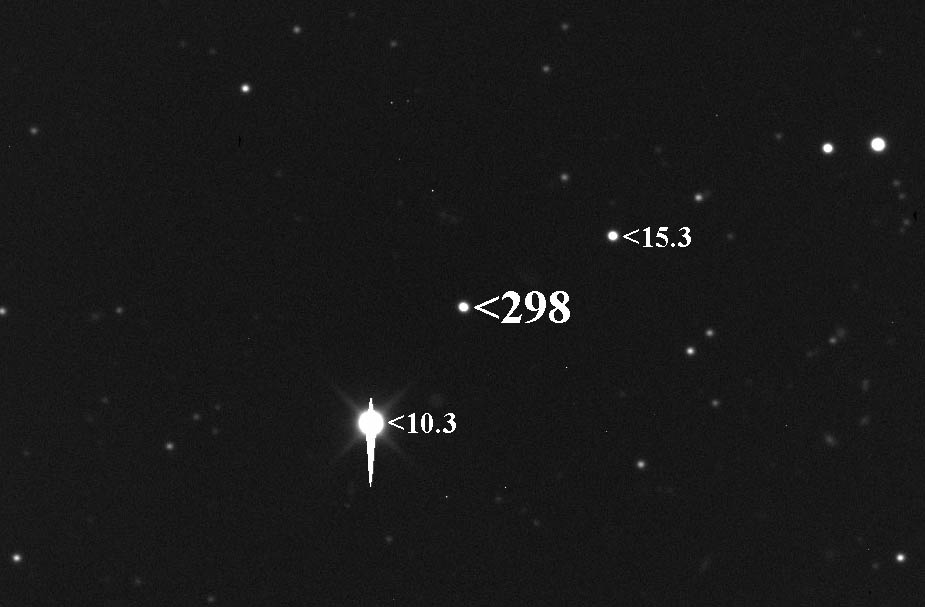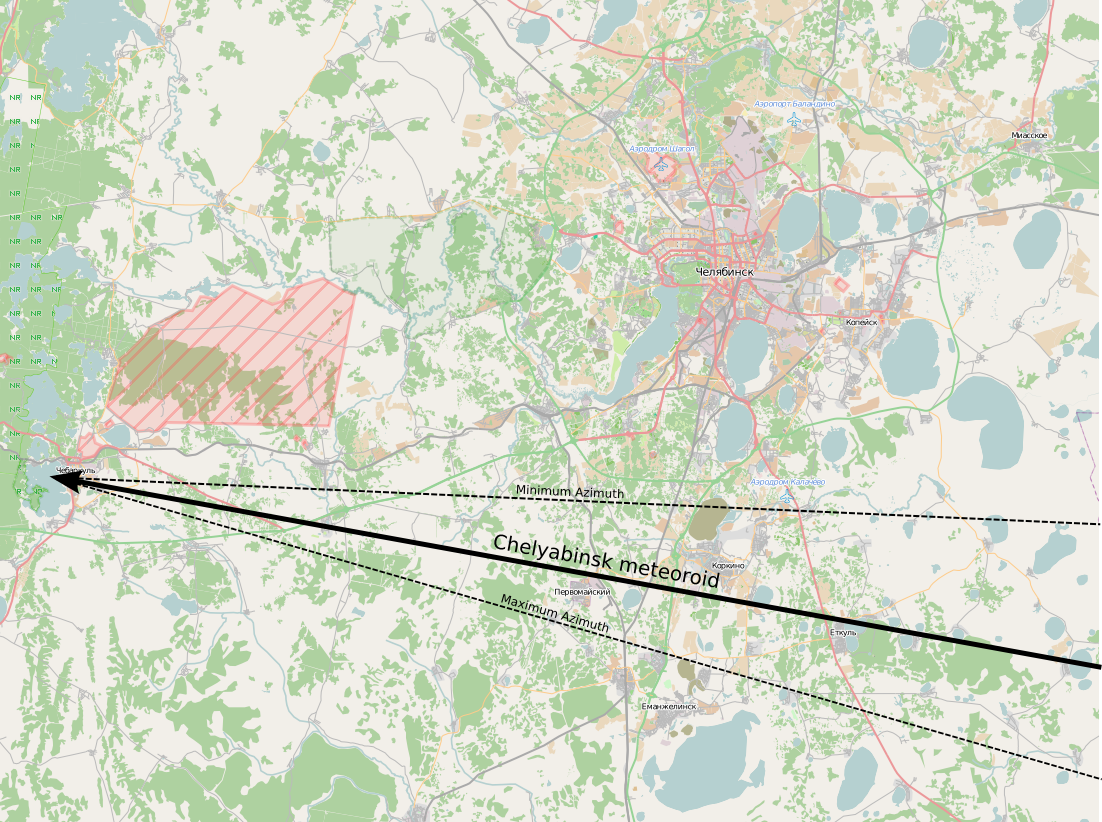|
Baptistina Family
The Baptistina family (FIN: 403) is an asteroid family of more than 2500 members that was probably produced by the breakup of an asteroid across 80 million years ago following an impact with a smaller body. The two largest presumed remnants of the parent asteroid are main-belt asteroids 298 Baptistina and 1696 Nurmela. The Baptistina family is part of the larger Flora clan. It was briefly speculated that the Chicxulub impactor was part of the Baptistina family of asteroids, but this was disproven in 2011 using data from the Wide-field Infrared Survey Explorer (WISE). The Baptistina family consists of darkly colored asteroids and meteoroids in similar orbits. Many mountain-sized fragments from its initial collision would have leaked into the inner solar system through orbital resonances with Mars and Jupiter, causing a prolonged series of asteroid impacts. Previously, this collision was believed to have occurred about 160 million years ago, and many impacts between 100 and 50 ... [...More Info...] [...Related Items...] OR: [Wikipedia] [Google] [Baidu] |
X-type Asteroid
The X-group of asteroids collects together several types with similar spectra, but probably quite different compositions. Tholen classification In the Tholen classification the X-group consists of the following types: * E-type – with high albedo (> 0.30), composed of enstatite, forsterite and feldspar. They are found in the inner main-belt. * M-type – the largest grouping, intermediate albedo, "metallic", composed of iron and nickel, thought to be the progenitors of nickel–iron meteorites. They are found around 3.0 AU and in the Hungaria region (innermost main-belt). * P-type – low albedos (< 0.10) with featureless red spectra; presumably composed of carbonaceous chondrites, and found in the outer main-belt and in the Jupiter trojan region. Since in this scheme the albedo is crucial in discriminating between the above types, some objects for which albedo information was not available were assigned an X-type. An example of this is 50 Virginia. SMASS cla ... [...More Info...] [...Related Items...] OR: [Wikipedia] [Google] [Baidu] |
Chicxulub Crater
The Chicxulub crater () is an impact crater buried underneath the Yucatán Peninsula in Mexico. Its center is offshore near the community of Chicxulub, after which it is named. It was formed slightly over 66 million years ago when a large asteroid, about in diameter, struck Earth. The crater is estimated to be in diameter and in depth. It is the second largest confirmed impact structure on Earth, and the only one whose peak ring is intact and directly accessible for scientific research. The crater was discovered by Antonio Camargo and Glen Penfield, geophysicists who had been looking for petroleum in the Yucatán Peninsula during the late 1970s. Penfield was initially unable to obtain evidence that the geological feature was a crater and gave up his search. Later, through contact with Alan R. Hildebrand in 1990, Penfield obtained samples that suggested it was an impact feature. Evidence for the crater's impact origin includes shocked quartz, a gravity anomaly, and tektites ... [...More Info...] [...Related Items...] OR: [Wikipedia] [Google] [Baidu] |
Impact Event
An impact event is a collision between astronomical objects causing measurable effects. Impact events have physical consequences and have been found to regularly occur in planetary systems, though the most frequent involve asteroids, comets or meteoroids and have minimal effect. When large objects impact terrestrial planets such as the Earth, there can be significant physical and biospheric consequences, though atmospheres mitigate many surface impacts through atmospheric entry. Impact craters and Impact structure, structures are dominant landforms on many of the Solar System's solid objects and present the strongest empirical evidence for their frequency and scale. Impact events appear to have played a significant role in the Formation and evolution of the Solar System, evolution of the Solar System since its formation. Major impact events have significantly shaped History of the Earth, Earth's history, and have been implicated in the giant impact theory, formation of the Earth� ... [...More Info...] [...Related Items...] OR: [Wikipedia] [Google] [Baidu] |
Cretaceous–Paleogene Boundary
The Cretaceous–Paleogene (K–Pg) boundary, formerly known as the Cretaceous–Tertiary (K–T) boundary, is a geological signature, usually a thin band of rock containing much more iridium than other bands. The K–Pg boundary marks the end of the Cretaceous Period, the last period of the Mesozoic Era, and marks the beginning of the Paleogene Period, the first period of the Cenozoic Era. Its age is usually estimated at around 66 million years, with radiometric dating yielding a more precise age of 66.043 ± 0.011 Ma. The K–Pg boundary is associated with the Cretaceous–Paleogene extinction event, a mass extinction which destroyed a majority of the world's Mesozoic species, including all dinosaurs except for birds. Strong evidence exists that the extinction coincided with a large meteorite impact at the Chicxulub crater and the generally accepted scientific theory is that this impact triggered the extinction event. The word "Cretaceous" is derived from the Latin "creta" (ch ... [...More Info...] [...Related Items...] OR: [Wikipedia] [Google] [Baidu] |
Chromium
Chromium is a chemical element with the symbol Cr and atomic number 24. It is the first element in group 6. It is a steely-grey, lustrous, hard, and brittle transition metal. Chromium metal is valued for its high corrosion resistance and hardness. A major development in steel production was the discovery that steel could be made highly resistant to corrosion and discoloration by adding metallic chromium to form stainless steel. Stainless steel and chrome plating (electroplating with chromium) together comprise 85% of the commercial use. Chromium is also greatly valued as a metal that is able to be highly polished while resisting tarnishing. Polished chromium reflects almost 70% of the visible spectrum, and almost 90% of infrared light. The name of the element is derived from the Greek word χρῶμα, ''chrōma'', meaning color, because many chromium compounds are intensely colored. Industrial production of chromium proceeds from chromite ore (mostly FeCr2O4) to produce ferro ... [...More Info...] [...Related Items...] OR: [Wikipedia] [Google] [Baidu] |
Phys
Physics is the natural science that studies matter, its fundamental constituents, its motion and behavior through space and time, and the related entities of energy and force. "Physical science is that department of knowledge which relates to the order of nature, or, in other words, to the regular succession of events." Physics is one of the most fundamental scientific disciplines, with its main goal being to understand how the universe behaves. "Physics is one of the most fundamental of the sciences. Scientists of all disciplines use the ideas of physics, including chemists who study the structure of molecules, paleontologists who try to reconstruct how dinosaurs walked, and climatologists who study how human activities affect the atmosphere and oceans. Physics is also the foundation of all engineering and technology. No engineer could design a flat-screen TV, an interplanetary spacecraft, or even a better mousetrap without first understanding the basic laws of physics. (. ... [...More Info...] [...Related Items...] OR: [Wikipedia] [Google] [Baidu] |
Chelyabinsk Meteorite
The Chelyabinsk meteorite (Russian: Челябинский метеорит, ''Chelyabinskii meteorit'') is the fragmented remains of the large Chelyabinsk meteor of 15 February 2013 which reached the ground after the meteor's passage through the atmosphere. The descent of the meteor, visible as a brilliant superbolide in the morning sky, caused a series of shock waves that shattered windows, damaged approximately 7,200 buildings and left 1,500 people injured. The resulting fragments were scattered over a wide area. The largest fragment raised from the bottom of Lake Chebarkul on 16 October 2013 had a mass of and the total mass of other 7 meteorite fragments found nearby was . Naming The meteor and meteorite are named after Chelyabinsk Oblast, over which the meteor exploded. An initial proposal was to name the meteorite after Lake Chebarkul, where one of its major fragments impacted and made a 6-metre-wide hole in the frozen lake surface. Composition and classificati ... [...More Info...] [...Related Items...] OR: [Wikipedia] [Google] [Baidu] |
Icarus (journal)
''ICARUS'' is a scientific journal dedicated to the field of planetary science. It is officially endorsed by the American Astronomical Society's Division for Planetary Sciences (DPS). The journal contains articles discussing the results of new research on astronomy, geology, meteorology, physics, chemistry, biology, and other scientific aspects of the Solar System or extrasolar systems. The journal was founded in 1962, and became affiliated with the DPS in 1974. Its original owner and publisher was Academic Press, which was purchased by Elsevier in 2000. The journal is named for the mythical Icarus, and the frontispiece of every issue contains an extended quotation from Sir Arthur Eddington equating Icarus' adventurousness with the scientific investigator who "strains his theories to the breaking-point till the weak joints gape." Abstracting and indexing This journal is indexed by the following services: * Science Citation Index * Current Contents /Physical, Chemical & E ... [...More Info...] [...Related Items...] OR: [Wikipedia] [Google] [Baidu] |
Chelyabinsk Meteor
The Chelyabinsk meteor was a superbolide that entered Earth's atmosphere over the southern Ural (region), Ural region in Russia on 15 February 2013 at about 09:20 Yekaterinburg Time, YEKT (03:20 Coordinated Universal Time, UTC). It was caused by an approximately Near-Earth object, near-Earth asteroid that entered the atmosphere at a shallow 18.3 ± 0.4 degree angle with a speed relative to Earth of 19.16 ± 0.15 kilometres per second (69,000 km/h or 42,690 mph). The light from the meteor was briefly brighter than the Sun, visible up to away. It was observed over a wide area of the region and in neighbouring republics. Some eyewitnesses also felt intense heat from the fireball. The object exploded in a meteor air burst over Chelyabinsk Oblast, at a height of around . The explosion generated a bright flash, producing a hot cloud of dust and gas that penetrated to , and many surviving small fragmentary meteorites. The bulk of the object's energy was absorbed by t ... [...More Info...] [...Related Items...] OR: [Wikipedia] [Google] [Baidu] |
Albedo
Albedo (; ) is the measure of the diffuse reflection of sunlight, solar radiation out of the total solar radiation and measured on a scale from 0, corresponding to a black body that absorbs all incident radiation, to 1, corresponding to a body that reflects all incident radiation. Surface albedo is defined as the ratio of Radiosity (radiometry), radiosity ''J''e to the irradiance ''E''e (flux per unit area) received by a surface. The proportion reflected is not only determined by properties of the surface itself, but also by the spectral and angular distribution of solar radiation reaching the Earth's surface. These factors vary with atmospheric composition, geographic location, and time (see position of the Sun). While bi-hemispherical reflectance is calculated for a single angle of incidence (i.e., for a given position of the Sun), albedo is the directional integration of reflectance over all solar angles in a given period. The temporal resolution may range from seconds (as ob ... [...More Info...] [...Related Items...] OR: [Wikipedia] [Google] [Baidu] |
V-type Asteroid
A V-type asteroid or Vestoid is an asteroid whose spectral type is that of 4 Vesta. Approximately 6% of main-belt asteroids are vestoids, with Vesta being by far the largest of them. They are relatively bright, and rather similar to the more common S-type asteroid, which are also made up of stony irons and ordinary chondrites, with V-types containing more pyroxene than S-types. A large proportion of vestoids have orbital elements similar to those of Vesta, either close enough to be part of the Vesta family, or having similar eccentricities and inclinations but with a semi-major axis lying between about 2.18 AU and the 3:1 Kirkwood gap at 2.50 AU. This suggests that they originated as fragments of Vesta's crust. There seem to be two populations of Vestoids, one created 2 billion years ago and the other 1 billion years ago, coming respectively from the enormous southern-hemisphere craters Veneneia and Rheasilvia. Fragments that ended up in the 3:1 Jupiter resonance were perturbed o ... [...More Info...] [...Related Items...] OR: [Wikipedia] [Google] [Baidu] |





